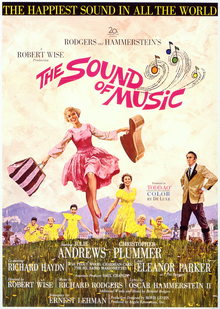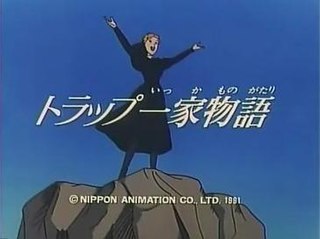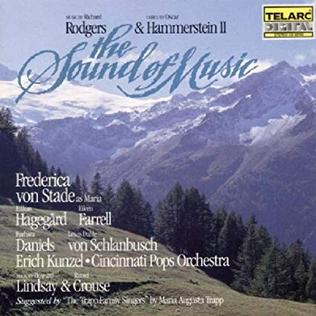
The Sound of Music is a musical with music by Richard Rodgers, lyrics by Oscar Hammerstein II, and a book by Howard Lindsay and Russel Crouse. It is based on the 1949 memoir of Maria von Trapp, The Story of the Trapp Family Singers. Set in Austria on the eve of the Anschluss in 1938, the musical tells the story of Maria, who takes a job as governess to a large family while she decides whether to become a nun. She falls in love with the children, and eventually their widowed father, Captain von Trapp. He is ordered to accept a commission in the German Navy, but he opposes the Nazis. He and Maria decide on a plan to flee Austria with the children. Many songs from the musical have become standards, including "Do-Re-Mi", "My Favorite Things", "Edelweiss", "Climb Ev'ry Mountain", and the title song "The Sound of Music".

Georg Ludwig Ritter von Trapp was an officer in the Austro-Hungarian Navy who became the patriarch of the Trapp Family Singers.

Rodgers and Hammerstein was a theater-writing team of composer Richard Rodgers (1902–1979) and lyricist-dramatist Oscar Hammerstein II (1895–1960), who together created a series of innovative and influential American musicals. Their musical theater writing partnership has been called the greatest of the 20th century.

Josef Meinrad was an Austrian actor. From 1959 until his death in 1996, Meinrad held the Republic of Austria's Iffland-Ring, which passes from actor to actor — each bequeathing the ring to the next holder, judging that actor to be the "most significant and most worthy actor of the German-speaking theatre".

Maria Augusta von Trapp DHS, often styled as “Baroness”, was the stepmother and matriarch of the Trapp Family Singers. She wrote The Story of the Trapp Family Singers, which was published in 1949 and was the inspiration for the 1956 West German film The Trapp Family, which in turn inspired the 1959 Broadway musical The Sound of Music and its 1965 film version.

"Edelweiss" is a show tune from the 1959 Rodgers and Hammerstein musical The Sound of Music. It is named after the edelweiss, a white flower found high in the Alps. The song was created for the 1959 Broadway production of The Sound of Music, as a song for the character Captain Georg von Trapp. In the musical, Captain von Trapp and his family sing this song during the concert near the end of Act II. It is a statement of Austrian patriotism in the face of the pressure put upon him to join the navy of Nazi Germany following the Anschluss. It is also Captain von Trapp's subliminal goodbye to his beloved homeland, using the flower as a symbol of his loyalty to Austria. In the 1965 film adaptation, the song is also sung by the Captain earlier in the film when he rediscovers music with his children.

The Trapp Family was a singing group formed from the family of former Austrian naval commander Georg von Trapp. The family achieved fame in their original singing career in their native Austria during the interwar period. They also performed in the United States before emigrating there permanently to escape the deteriorating situation in Austria leading up to World War II. In the United States, they became well known as the "Trapp Family Singers" until they ceased to perform as a unit in 1957. The family's story later served as the basis for a memoir, two German films, and the Rodgers and Hammerstein Broadway musical The Sound of Music. The last surviving of the original seven, Maria Franziska, died in 2014 at the age of 99. The youngest and last surviving member of the Trapp Family Singers is Johannes von Trapp.

The Sound of Music is a 1965 American musical drama film produced and directed by Robert Wise from a screenplay written by Ernest Lehman, and starring Julie Andrews and Christopher Plummer, with Richard Haydn, Peggy Wood, Charmian Carr, and Eleanor Parker. The film is an adaptation of the 1959 stage musical composed by Richard Rodgers, with lyrics by Oscar Hammerstein II and a book by Lindsay and Crouse. It is based on the 1949 memoir The Story of the Trapp Family Singers by Maria von Trapp and is set in Salzburg, Austria. It is a fictional retelling of her experiences as governess to seven children, her eventual marriage with their father Captain Georg von Trapp, and their escape during the Anschluss in 1938.

The Story of the Trapp Family Singers is a 1949 memoir written by Maria Augusta von Trapp, whose life was later fictionalized in Rodgers and Hammerstein's Broadway musical The Sound of Music in 1959.

Trapp Family Story is a 1991 Japanese animated series by Nippon Animation, based on the story of the real-life Austrian singing family the Trapp Family. It is a part of the World Masterpiece Theatre franchise, which adapted classic works of literature into animated TV shows. 40 episodes aired on Fuji TV.
"The Lonely Goatherd" is a popular show tune from the 1959 Rodgers and Hammerstein musical The Sound of Music.

Maria Agatha Franziska Gobertina von Trapp was the second-oldest daughter of Georg von Trapp and his first wife, Agathe Whitehead von Trapp. She was a member of the Trapp Family Singers, whose lives inspired the musical and film The Sound of Music. She was portrayed by Heather Menzies as the character "Louisa". She died at age 99, and was the last surviving sibling portrayed in the film.
"No Way to Stop It" is a show tune from the 1959 Rodgers and Hammerstein musical The Sound of Music, but not included in the later film version from 1965.
"Climb Ev'ry Mountain" is a show tune from the 1959 Rodgers and Hammerstein musical The Sound of Music. It is sung at the close of the first act and is sung again in the epilogue of the second act by the Mother Abbess. It is themed as an inspirational piece, to encourage people to take every step toward attaining their dreams.

Ruth Leuwerik was a German film actress, one of the most popular stars of German film during the 1950s. She appeared in 34 films between 1950 and 1977. Leuwerik is probably best known for her portrayal of Maria von Trapp in the films The Trapp Family and The Trapp Family in America.

The Trapp Family in America is a 1958 West German comedy drama film about the real-life Austrian musical Trapp Family directed by Wolfgang Liebeneiner and starring Ruth Leuwerik, Hans Holt, and Josef Meinrad. It is a sequel to the 1956 film The Trapp Family. It was shot at the Bavaria Studios in Munich. The film's sets were designed by the art director Robert Herlth.
"Something Good" is a song written by Richard Rodgers for the 1965 film version of the 1959 stage musical The Sound of Music. It replaced the original song sung by Maria and Captain Georg von Trapp called "An Ordinary Couple". Since then the song has been used in the various reproductions of the play and most recently the 2015 television special, The Sound of Music Live.
Virgilia Lütz was a German Benedictine. She was the reigning abbess of Nonnberg in Salzburg from 1921 until her death in 1949. During her reign, Maria von Trapp entered the abbey as a postulant. Lütz is the basis for the Mother Abbess character in The Sound of Music.
The Sound of Music Live is a television special that was originally broadcast by ITV on 20 December 2015. The special was an adaptation of Rodgers and Hammerstein's 1959 Broadway musical The Sound of Music, starring Kara Tointon as Maria von Trapp, performed and televised live from 3 Mills Studios in London.

The Sound of Music is a 70-minute studio album of Richard Rodgers's and Oscar Hammerstein's 1959 musical, starring Frederica von Stade, Håkan Hagegård and Eileen Farrell, performed with the Cincinnati Pops Orchestra under the direction of Erich Kunzel. It was released in 1988.














